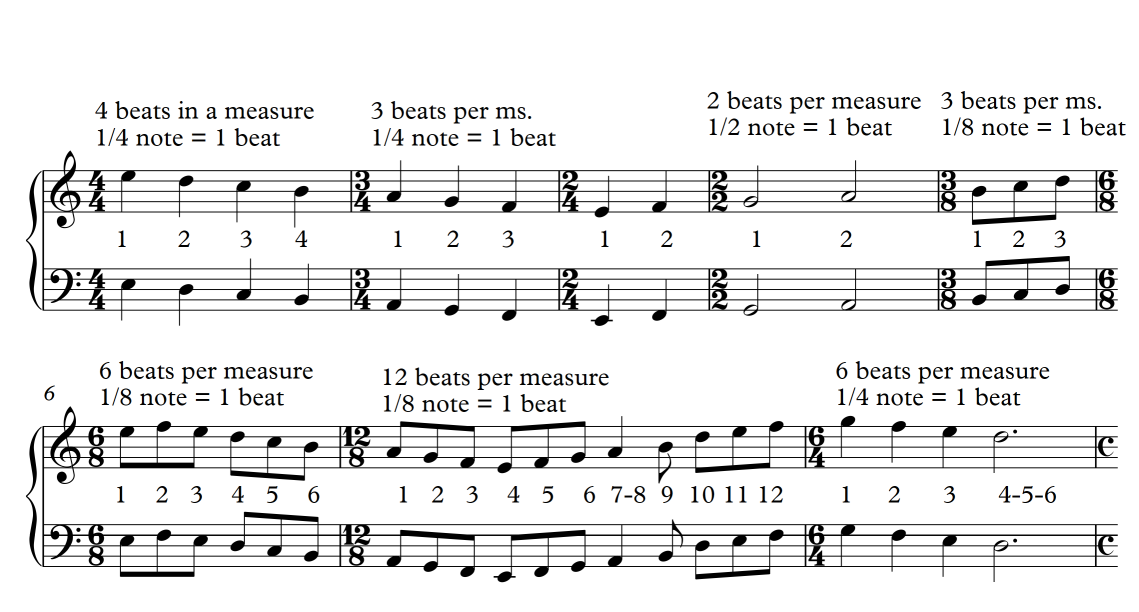Introduction to Music
for those wanting to become musicans, or improve their musicianship
Time Signatures and Counting
Up until now we’ve talked about each measure having 4 beats and the quarter note equaling one beat. Can we have 20 beats in a measure? Can the 8th note equal one beat? Yes, to both questions. But what tells us how to know this?
Time signatures do.
A time signature tells us how many beats are in a measure and what type of note equals one beat. The time signature is the first thing that occurs (from left to right) after the clef. It only happens at the start of a piece of music unless there is a change to the time signature. (You may also see the term ‘meter’ used instead of time signature). The most common time signature is 4/4 time. This means that there are 4 beats in a measure and the quarter note gets one beat. Click on the image to see the full size, easier to read version.
The top number of a time signature tells how many beats there are in a measure. The bottom number tells you what type of note gets the beat. The top number can be anything from 1 to infinity. The bottom number tells you what type of note gets the beat. For the bottom number, the way I look at is this: take just the bottom number and put a 1 above it and read it as a fraction. Thus for 4/4 time, make it 1/4 and say it – “quarter.” That’s the type of note that gets the beat. For 3/8 time, 3 beats in a measure, then 1/8 = “eight” so the eight note gets the beat. The bottom number can be 1 or any multiple of 2.
Other time signatures you will run across include: 2/4, 3/4, 6/4, 2/2, 3/2, 3/8, 6/8, 9/8 and 12/8. Those are the more common time signatures. I’ve seen 1/1 (one whole note per measure) but only for a measure or two, and in the music of J.S. Bach, the great 18th century organist and composer, 16/32, 16 beats in a measure and the 32nd note (twice as fast as the 16th) gets one beat.
While it is true that some time signatures are more often used in faster music or slower music, the time signature itself does not say anything whatsoever about the speed of the music. Yes, 2/2 time, which looks just like 4/4 time, is often faster, it isn’t always. What determines the speed of a piece of music is the tempo marking. See below.
The numbers show how you can count the different time signatures. See how in 6/8 time you count the eighth note as one and the quarter note gets 2 beats? How about 2/2 time? In it, the quarter note is 1/2 a beat long while the whole note is only 2 beats long. In time signatures with a 2 or 4 on the bottom, it is typical to divide the subdivisions into groups of two or four. You’ll see examples of that in future articles. In time signatures with 8 or 16 on the bottom, it is more typical to group the subdivisions into groups of 3. See the horizontal line joining the notes? That is what is known as a beam. When two eight notes are joined together, instead of using a flag, we use the beam. Since a 16th note has two flags, when joined together, we use 2 beams.
Tempo is the speed of a piece of music. Just above the time signature at the beginning of the music, a composer may indicated the speed they want the music performed at. This is the tempo marking. That, and only that, determines how fast a piece of music is. A time signature simply tells us how many beats are in a measure and what type of note gets the beat, not how fast to play.
I wonder what that “C” at the end of the last line of music means? (next time)
If you’re reading this close to when it is posted, no new posts for a few weeks so I can enjoy the Christmas holiday season.
Next time: Introduction to Symbols


One reply on “Introduction to Music, Part 6 (Time Signatures)”
Reblogged this on duART Studio Blog.